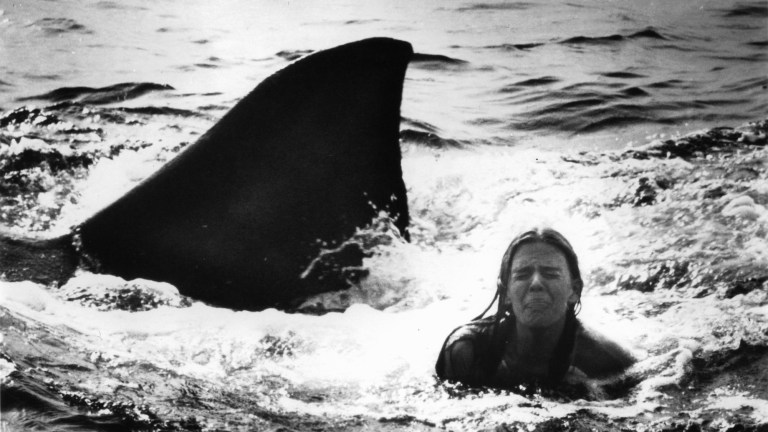Jaws 2: A Movie Where the Novelization Was Better
Jaws 2 is nobody's favorite sequel, but a novelization based on an earlier draft of the screenplay promised a more complex movie filled with mobsters, baby seals, and Bruce's baby mama shark.

With the huge success of Jaws, it was inevitable that Universal Pictures would be interested in a sequel. But aside from the ludicrous premise of the same town getting terrorized by a shark again, Jaws 2 was saddled with two directors, massive reshoots, an unhappy star, and a script that never quite seemed finished. That it’s still a watchable effort is hard to believe, but it’s telling that the novelization—which barely resembles the finished movie—is actually better.
The studio signaled its desire for a sequel not long after Jaws became a blockbuster hit and cultural phenomenon, but the first roadblock producers Richard D. Zanuck and David Brown faced was that Steven Spielberg had no desire whatsoever to come back and direct it. In fact, Spielberg was one of the few crew members from the original film who didn’t return. Conversely, screenwriters Carl Gottlieb and Howard Sackler, who had penned various drafts of Jaws, both contributed to Jaws 2, while production designer Joe Alves and visual effects supervisor Robert A. Mattey also worked on the sequel.
And of course original cast members Roy Scheider (Chief Brody), Lorraine Gary (Ellen Brody), Murray Hamilton (Mayor Vaughn), and Jeffrey Kramer (Deputy Hendricks) encored as well, with Joseph Mascolo aboard as a new heavy, the avaricious real estate developer Len Peterson. A new director was found as well in John D. Hancock, whose previous films included the 1971 cult horror classic Let’s Scare Jessica to Death and the 1973 sports drama, Bang the Drum Slowly. But naturally the biggest question was: what was the story going to be?
Jaws 2 Started Out Darker
One of the first ideas for the film was to make a prequel about the sinking of the USS Indianapolis and the slaughter of much of its crew by sharks, the horrifying tale related by Quint (Robert Shaw) in the first movie. But that was shot down by Universal head Sid Sheinberg, so Hancock and his wife, writer Dorothy Tristan, ground out a new script in which Chief Brody is still suffering from PTSD due to the events of the original film while Amity Island is economically depressed and failing as a result of the shark incident.
The centerpiece of the finished film, a bunch of teenagers going out sailing and getting attacked by a new shark, is still found in this early script as well. Quint’s son also makes an appearance in the story. Meanwhile Brody ultimately defeats the new shark by using a boat propeller to slice it up with the help of Peterson and a businessman named Boyle (who ends up dying). Hancock actually began filming this screenplay (or a draft of it anyway) and was shooting for about a month when Universal unceremoniously canned him, apparently unhappy with the darker tone of the film.
Although Spielberg briefly flirted with returning at this point, the directorial reins were eventually handed over to Jeannot Szwarc, a French director who had mainly helmed TV episodes up to that point (including segments of Night Gallery where Spielberg honed his craft as well). At the same time, Gottlieb was brought in to lighten up the tone of the movie by adding humor and a more adventurous vibe akin to the first film.
Portions of the movie was filmed in Martha’s Vineyard again with extensive shooting also done in Florida. As before the mechanical sharks never quite worked right, although they were a little better behaved than the original Bruce(s) in Jaws. Less well behaved was Scheider, who reportedly came back only for the money but was unhappy throughout much of the shoot. He and Szwarc fought constantly, even allegedly getting into a physical altercation at one point. The film also went through five weeks of reshoots after principal photography was completed, with the final budget coming in at $30 million, nearly three times that of the first film.
An Alternate, Literary Jaws 2
Back in the 1970s (and even into the 1980s), movie novelizations were often released before the actual film came out. (Incredibly, I walked into a bookstore in 1980, a month before the release of The Empire Strikes Back, picked up the paperback and read the words “I am your father” right there on the page. Can you even imagine that happening now?). So it was with Jaws 2; the book was published in January 1978, five months before the film opened in June. But anyone who read the book, written by Hank Searls, and then saw the movie months later was in for a surprise. What was on the page was very different, and arguably better, than what emerged on the screen.
The book places a lot more emphasis on Brody’s PTSD from the shark attacks and parallels that with the trauma also suffered by his oldest son, Michael, as a result of those events. The Brody of the book (and the script it was based on) is a much more tormented and traumatized figure, of which only a relatively minor amount still remains in the completed film (as for Mike, in the movie he’s reduced to a horny teenager who disobeys his dad, ditches his summer job, and puts his little brother in danger just so he can take the new hottie in town sailing).
Based on “the screenplay by Howard Sackler and Dorothy Tristan,” the novel seems to be based on an earlier version of the script that Hancock had begun shooting. One thing’s for sure: instead of the very simplified movie we got, which is basically a remix of the first movie, this version of Jaws 2 is a much more complex piece of material. Boyle and Quint’s son are gone, but a diver named Tom Andrews figures into the story, as does a mafia boss named Moscotti and a crooked New York City cop they call Jepps.
In fact, it’s Jepps that Brody initially blames for this new round of disturbances on the island, thanks to Jepps’ despicable tendency to drunkenly shoot at seals from the beach near his house. This is, as presented in the book, Brody’s own form of denial that there could be another shark in the waters off Amity—a very different proposition from the movie in which Brody, armed with a photo taken by a diver just before he was killed quickly comes to the conclusion that there’s a new great white in town and tries, to no avail, to again convince Mayor Vaughn and the town council of the danger. The Brody of the book is a more complicated, anguished character.
Speaking of that photo, Brody doesn’t get to see it in the book. The drugstore owner who develops it, Starbuck, realizes its implications and deliberately withholds it from the chief to avoid deepening the economic calamity that has befallen the island. The people of Amity are a desperate, selfish, actively unpleasant lot in the book, to the point that they are actually eager to welcome a casino to their peaceful little enclave, a casino backed by the Mafia in the form of the aforementioned Moscotti.
While a mob subplot factored into the original Peter Benchley novel of Jaws (they were shaking down Mayor Vaughn), that aspect of the book was eliminated from the movie version. It’s back here in the Searls novel, with the mafia playing an even bigger role this time around. Moscotti and his son are active participants in the story here. Interestingly the mob plot from the Benchley book is mentioned in the Jaws 2 novelization, along with Ellen Brody’s also excised affair with Matt Hooper, placing the novelization in a nether region between Benchley’s book and Spielberg’s film.
There are, in fact, so many subplots at work in the book—the mob, the casino, the hidden shark photo, Jepps the cop, the Brody family trauma, Chief Brody’s rescue and adoption of a baby seal(!), and the revelation in the book that the shark this time around is female and pregnant by the shark from the first book/film (!!)—that the teen sailing party which takes up fully half of the finished Jaws 2 movie only appears in the final 50 pages or so of the novel, while the shark itself takes a back seat for much of the book to the other goings-on in Amity.
And yet, Jaws 2 is a richer, more satisfying, and layered experience to read that to watch as a film. Searls, to his credit, makes a real novel out of whatever screenplay he was working from and if that screenplay had been used, the movie of Jaws 2 would have possibly been a darker, grittier, and certainly more violent story than the one we got, with more nuanced characters and themes, and a fuller cohesive story. Who knows, it might have painted a dramatically different portrait of Amity, its inhabitants, and its ongoing “shark problem?”
The movie We Wanted, Not the Movie We Needed
In the end, Jaws 2 came out and did respectable business, not nearly as much as its predecessor, but still earning a healthy $208 million worldwide (in 1978 dollars). As for the movie itself, Universal’s most expensive up to that point, it’s actually pretty decent. It doesn’t compare to the first film, but it looks great, it moves fast, it’s stylishly directed, and it features a few genuinely harrowing moments. Roy Scheider turns in a fine performance, ably supported again by Lorraine Gary and Murray Hamilton. John Williams is even back with another terrific score as well.
But at the same time, it really does play as a rehash of Jaws. The shark shows up and starts attacking people, Brody tries to warn everyone, and he ends up out on the ocean to defeat the monster, only this time with a bunch of kids instead of Robert Shaw and Richard Dreyfuss. The teens themselves are barely sketched out as people, oddly prescient of the cannon fodder found in movies like Friday the 13th in the next decade. In fact, much of the second half of Jaws 2 feels like a slasher film, as the monster relentlessly stalks and munches on people. Half its face is even burned, giving it an extra horror movie patina. We also see far too much of it this time around, and the less we say about the scene in which the beast drags a helicopter under the waves, the better.
While it’s serviceable—and a regular The Godfather, Part II compared to the two unwatchable sequels that followed—Jaws 2 could have been much more, and much different. In the pages of Hank Searls’ novelization and that unused screenplay by Howard Sackler and Dorothy Tristan, there lurks a movie about the effects of PTSD and calamity on people, and how they respond when confronted directly with that calamity one more time. It’s the Jaws 2 we’ll never see.
